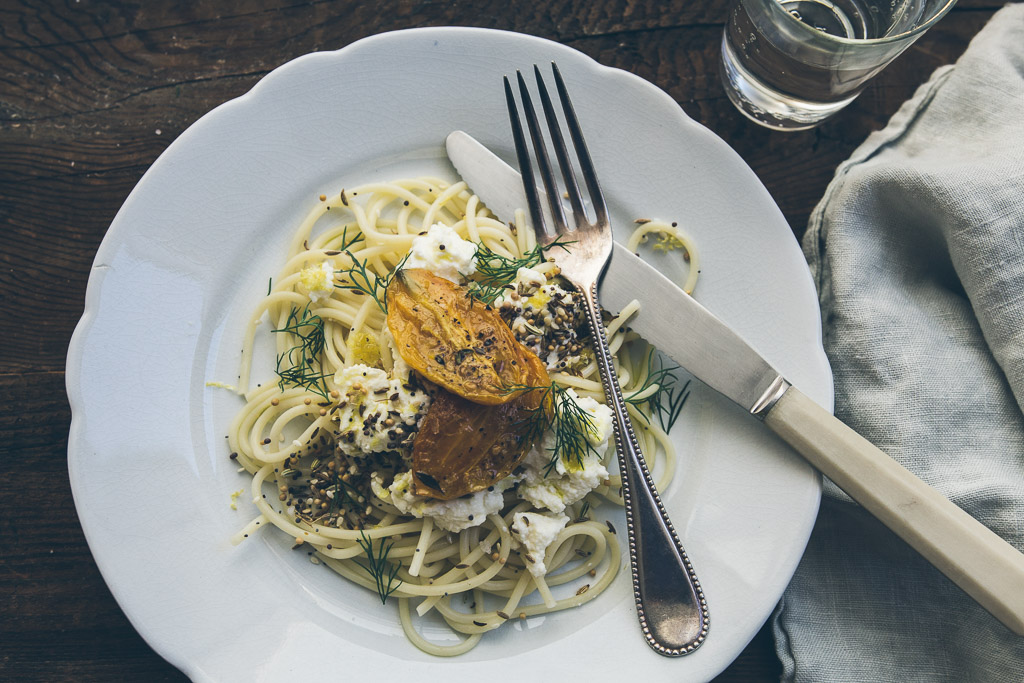You’ll be happy to hear I’m (mostly) done complaining about being back under grey Northwest skies. Shaking the nasty head cold I came home with has helped brighten my mood. As did seeing so many fantastic folks from the Seattle food community at Book Larder’s 5th birthday bash last night.
The food was mightily on point, too. My friend Kyle made ridiculously delicious lamb meatballs bathed in some sort of creamy tomato business that everyone was swooning over. And pastry chef extraordinaire, Rachael Coyle, baked a carrot cake studded with dates and nuts and layered with the fluffiest mascarpone filling that made me lose all restraint. (I may or may not have gone back for thirds.)
Also, a brute of a storm is rolling into town this weekend. There’s talk of gale-force winds and power outages. Beau and I have battened down our hatches and are planning to spend the next couple days indoors playing cards, reading, watching movies and cooking (as long as we have power), which sounds like the perfect way to spend a blustery fall weekend.
Another thing that boosted my mood this week is this spicy spaghetti with roasted cauliflower, currants, pine nuts and sardines. This humble, improvised dinner was just the sort of comfort food I needed. Creamy, nutty and salty-sweet, it was a happy coincidence of pantry staples that yielded a whole much greater than the sum of its parts. A sort of weeknight dinner alchemy. And the best part is that it somehow managed to taste even better today when we had the leftovers for lunch.
Good ingredients are key here. Especially, the sardines. I used a can of the amazing sardines I brought back from Portugal. I recommend searching out good quality Portuguese, Spanish or Italian sardines for this dish. (A few mashed up anchovy fillets would work in a pinch.) And for those of you who are not fans of canned fish--I hear you. I would never open a can of sardines and eat them with a fork like Beau does. That’s far too fishy for me! But against a backdrop of earthy roasted cauliflower, sweet-tart dried currants, salty parmesan and toothsome spaghetti, sardines lend just the right amount of briny umami to round out this dish.
I cannot say precisely whether it was seeing so many friends this week, or the mood-boosting properties of all the sardines I ate, or the excitement of preparing for this weekend’s storm, or possibly even the carrot cake-induced sugar rush I experienced yesterday that lifted my mood. What I can say is that I’m grateful to be feeling more at home in our little home. And that this pasta is my new favorite cold-weather comfort food.
Spaghetti with Roasted Cauliflower, Currants, Pine Nuts, Chile and Sardines
- 1 medium head cauliflower
- 6-8 tablespoons good quality extra-virgin olive oil
- Sea salt or kosher salt, to taste
- 12 oz. dried spaghetti
- 3-4 cloves garlic, minced or pressed
- Generous pinch chile flakes (or to taste)
- ¼ cup capers, rinsed
- ¼ cup dried currants
- 1 can sardine filets (about 4 oz.)
- 1 cup finely grated parmesan, plus additional to garnish
- ½ cup toasted pine nuts
Preheat your oven to 450° F.
Wash and dry your cauliflower well. Remove any tough leaves and stalks and toss. Remove the tender, pale green leaves and set aside. Slice the cauliflower into ½-inch thick slices (the flat sides of sliced cauliflower make more uniform contact with the pan allowing the cauliflower to brown more evenly). Arrange the cauliflower and tender leaves in a single layer on a rimmed sheet pan (use parchment paper for easier clean-up if you want). Brush with 2-4 tablespoons of the olive oil. The amount you need will depend on the size of your cauliflower--you want it coated on all sides. Sprinkle with salt and roast until the cauliflower is just tender and nicely browned, about 20 minutes, turning once.
While the cauliflower is roasting, bring a large pot of generously salted water (it should taste like the sea) to the boil. Add the spaghetti and cook, stirring occasionally, until al dente. Reserve 1 cup of the pasta-cooking water. Drain the pasta and place it back in the pot. Add a tablespoon or so of the cooking water if necessary to keep it from sticking to the pot.
When the cauliflower is done, remove it from the oven and set aside. Heat 4 tablespoons of the olive oil in a large skillet over medium heat. Add the garlic and chile flakes and cook until fragrant, about a minute. Add the capers, currants and sardines. Reduce the heat to medium-low and cook, stirring often until the ingredients are heated through. Smash the sardines with the back of a wooden spoon if necessary to break them up. Cut the cauliflower into bite-sized pieces and add it to the pot with the spaghetti along with the cheese and ½ cup of the reserved pasta water. Cook over low heat, stirring well, until the cheese has melted and formed a sauce with the pasta water. Taste and add a bit more salt if necessary and a bit more pasta water if it seems dry. Serve hot sprinkled with the toasted pine nuts and extra grated parmesan.
Makes 4 servings.






























